For the Future of Our Communities, Labor Support for The Green New Deal
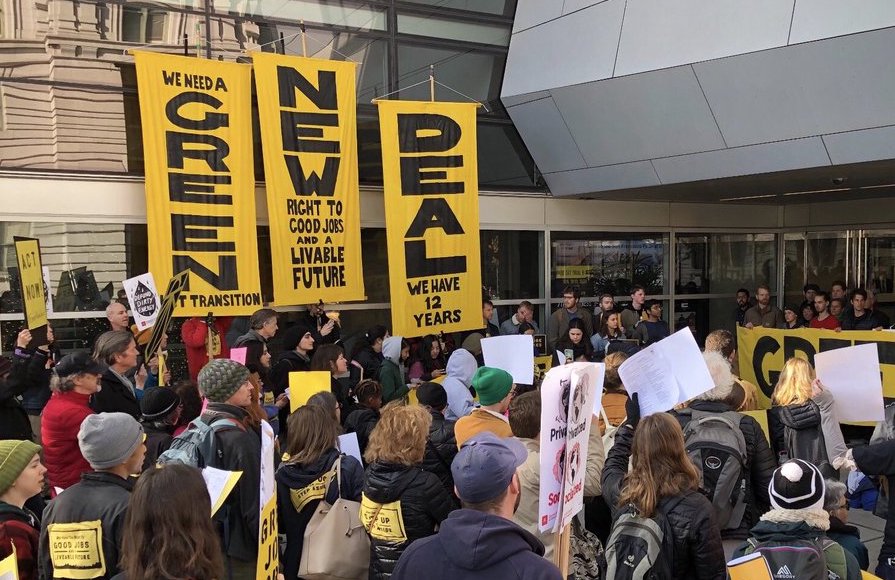
(photo: @sunrisemvmt)
Four years ago, the New York climate march brought 300,000 people to the streets of Manhattan to demand action from national and world leaders. Marching in New York City with my family, we witnessed how thousands of people from all walks of life filled the streets with energy, passion, and hope for a better future for our children and grandchildren. 32BJ SEIU, the labor union I am honored to lead, played a vital part in the People’s Climate March because our members live and work in communities that are affected by climate change.
We reside in coastal cities that have been flooded by storms like Hurricane Sandy. Our urban areas suffer with skyrocketing asthma rates. Many of us have families in the global south that have been devastated by climate change. We march and organize to bring attention to this existential crisis and demand action now. And we know that solutions can be found that both generate jobs and deliver sustainable energy.
As the new crop of progressive legislators in Congress is showing us all, the time to be bold on issues like climate change, the economy, and immigration is now. Last week Representative-elect Alexandria Ocasio-Cortez announced the introduction of the Green New Deal, a plan to make climate change, clean air, clean water, and reductions in pollution a priority for the new Congress when its members take office in January.
As a union representing 163,000 doormen, security officers, cleaners, and airport workers up and down the east coast, we support this bold vision to reduce greenhouse gasses, switch to renewable energies, and create good jobs. It’s both doable and indispensable.
For labor unions like ours, climate change is an environmental issue, an economic opportunity, and a political challenge that can destabilize our societies. We need to be ambitious and that requires us to think on a large scale and allocate the appropriate finances to fully address the climate threats that our planet is facing.
These threats are environmental and economic, and they will require investments in the communities historically dependent on fossil fuel extraction and production so the transition to renewable energy doesn’t leave “coal country” out in the cold. This is an opportunity to re-industrialize America with a green economy, with jobs that, with the right training, can provide career ladders for many low-wage workers who struggle to afford the high cost of living.
32BJ has a Green Buildings Program that serves as a good example and learning experience. The program, which trains existing building superintendents how to make residential buildings in New York more energy efficient, was meant to reduce the 77% of New York City’s greenhouse gas emissions that are produced by residential buildings. It has taught us that investing in long-term training and education programs for current employees can help them transition into the green economy and even become leaders in these efforts.
When these jobs are well paid, with benefits and union representation, green initiatives can further support local communities already dealing with the impacts of climate change. Initiatives like the Climate Jobs New York Program, which includes legislative requirements for labor standards in the creation of new wind and solar energy jobs across the state, show us that it is possible and deeply impactful when good union jobs are a central tenet of green job initiatives.
Directly impacted communities, those who have done the least to cause climate change—the poor, people of color, immigrants—and are suffering the most also need good jobs, affordable modernized public transportation, and big investments in renewable and solar energy in order to survive and thrive through the projected climate threats to come.
As Congress weighs the viability of a Green New Deal, we urge elected officials, labor unions, environmental groups, and community organizations to support its vision and to be smart, compassionate, and bold.
While there is much going on around the globe today that is disturbing and disheartening, it is also a time for hope. Let’s keep moving, marching, organizing, voting, and winning.
***
Hector Figueroa is president of 32BJ of the Service Employees International Union, representing 175,000 property-service workers up and down the east coast. On Twitter @figue32bj & @32BJSEIU.
***
Have an op-ed idea or submission for Gotham Gazette? Email This email address is being protected from spambots. You need JavaScript enabled to view it.
New York’s Opportunity to Become a Model for Effective Civics Education
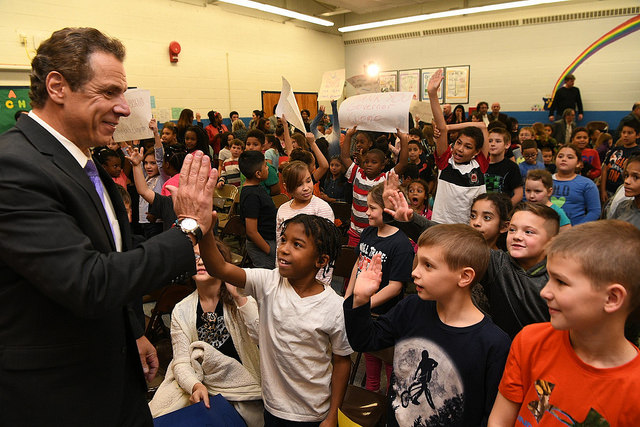
(photo via the Governor's Office)
Could New York be the next state to catch the civics bug and modernize its civics education standards? Hopefully, state legislators and policymakers are watching Massachusetts, which just took a big step forward by creating a national model for effective civics education.
Two short days after the November 6 election, Massachusetts adopted cutting-edge legislation (S-2631) that, when implemented, will ensure that every Massachusetts student receives a project-based civics education, equipping them with the skills, knowledge, and dispositions for lifelong civic participation in our 21st century democracy. This legislation, the most substantive civics education bill passed in the country in recent history, may show New York the way forward.
Like many states nationwide that are proposing reforms to their civics education standards, Massachusetts may have felt the need to respond to the current civic reckoning. It seems like policymakers may finally realize that one of the potential consequences of deprioritizing civics education in schools is an electorate that does not understand how democracy works or have the civic skills to advocate for systemic change to issues impacting themselves and their community.
The lack of civic knowledge and skills has resulted in an electorate that does not actively participate in politics or believe that government is relevant to their daily lives. In one fell swoop, Massachusetts has positioned itself as a model state for effective civics education. New York, which prides itself on being a state that sets national legislative and policy trends, should take note.
To contextualize the current state of New York’s democracy and why civics education is needed “now more than ever,” the state has historically ranked at the bottom of the national voter turnout list. That’s why it’s so impressive that almost 50 percent of registered New York voters cast a ballot on November 6. According to the Journal News, this year was the “highest turnout for a midterm election in almost a quarter-century.” Compare that to turnout in 2014 when only 33 percent of New Yorkers cast a ballot in the midterms.
Part of the reason for our state’s historic, low voter turnout is our antiquated voting laws. New York requires voters to register 25 days before the election, they cannot register to vote online unless they have a DMV-issued identification, 16- and 17-year-olds are not allowed to pre-register to vote when they obtain said DMV-issued identification, and New Yorkers cannot vote early - unlike voters in 37 states. One can only hope that the new leadership in the state Legislature can bring our voting laws into the 21st century to address some of the root causes of our participation problem.
But another root cause for New York’s low voter turnout is that the state isn’t effectively educating young people for civic participation.
To be fair, New York already mandates that all students take Participation in Government (also known as PIG), a one-semester civics education course, before graduating from high school. On its face PIG should do the trick as the course is intended to provide students with “opportunities to become engaged in the political process by acquiring the knowledge and practicing the skills necessary for active citizenship.” The reality is that while PIG is aligned with principles of Action Civics on paper, PIG as implemented falls short.
Action Civics is a 21st-century civics education pedagogy that is a student-centered, project-based approach to develop the individual skills, knowledge, and dispositions necessary for 21st-century democratic practice. As implemented, PIG does not educate students about local democratic structure, help them learn about processes by engaging in those processes, or how to research, analyze, propose, debate, and advocate for their collectively determined solution(s). By and large, PIG as implemented is civics as usual, a largely passive form of learning that is often a senior year after-thought based on rote memorization of random government facts.
Teaching civics well requires robust professional development and curricular resources from the state. Even if teachers wanted to teach PIG as intended, many are not provided the resources or training necessary to do so effectively. There are very few resources or professional development courses designed to equip educators to navigate the discussion and debate of community issues or local democratic structures, and implement nonpartisan, student-led project-based learning in the classroom.
There’s also no accountability system in place to ensure teachers measure student learning and ensure that their students develop the civic knowledge, skills, and dispositions necessary for lifelong civic participation in our 21st century democracy.
The takeaway is that PIG is being implemented haphazardly and inconsistently statewide. The fact that PIG is being implemented inconsistently only further widens the Civic Engagement Gap plaguing underserved school districts statewide. The reality is that students from rural and low socioeconomic urban communities are 50 percent less likely to study how laws are made, and 30 percent less likely to report having experiences with deliberative discussions in their classes.
Fortunately, all is not lost. The New York State Education Department (NYSED) made a commitment to modernizing New York’s civics standards when they added the College, Career and Civic Readiness Index (CCCRI) and created a graduation “seal of civic engagement” in the state’s plan to comply with the federal Every Student Succeeds Act. While the CCCRI establishes a baseline for holding schools accountable for ensuring students’ civic readiness, NYSED has yet to define “civic readiness.” NYSED also needs to define the criteria for how students can earn the seal of civic engagement and then ensure that every student is granted meaningful opportunities to achieve it.
As a member of a task force NYSED recently established to propose recommendations about how to define civic readiness and the criteria for the seal of civic engagement, I will advocate for a robust civics education for every student in New York.
It is incumbent upon us as a state to follow the lead of Massachusetts and others in adopting a rigorous definition of civic readiness and investing in professional development to prepare educators to teach modernized civics standards. Most importantly, NYSED must distribute funding equitably to districts, prioritizing those with greatest need to help them implement new mandates. Doing so would help strengthen New York’s democracy by ensuring that more New Yorkers have the knowledge and skills necessary to participate in our 21st-century democracy; and hopefully vote in all elections. Anything less would only widen the Civic Engagement Gap.
***
DeNora Getachew, New York City Executive Director of Generation Citizen. On Twitter @DeNoraGetachew & @GenCitizen.
***
Have an op-ed idea or submission for Gotham Gazette? Email This email address is being protected from spambots. You need JavaScript enabled to view it.
The Fuzzy Fine Print of Amazon’s Queens Real Estate Deal
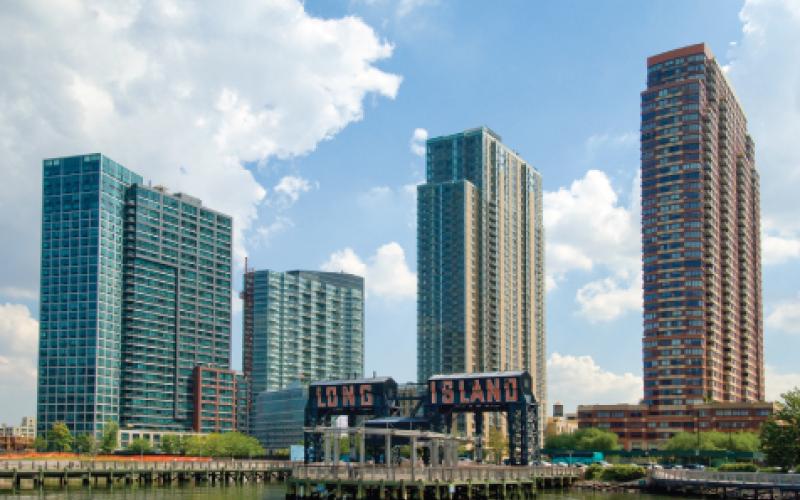
(image via NYC EDC)
The first of several New York City Council public oversight hearings on the deal to bring an Amazon campus to Long Island City will be held Wednesday at City Hall. Titled by the Council as “Exposing the Closed-Door Process,” the questions should concern not just the big-picture issues but also some fine print regarding the company’s acquisition of city-owned real estate.
Of course, the estimated $3 billion in tax breaks and subsidies in the deal made among Amazon, the state, and the city deserve scrutiny, though, except for a state capital grant that could reach $505 million, those questions -- as Gotham Gazette previously reported -- mostly concern revising existing policy.
For example, the Citizens Budget Commission warns that "offering Amazon benefits that go well above the current cap and expiration date" of the Excelsior Jobs Program -- up to $1.2 billion in state tax credits -- "sets a concerning precedent.”
National subsidy watchdog Good Jobs First points out that the city's decision to have Amazon contribute PILOTs, or payments in lieu of taxes, into a local infrastructure fund, would "further enhanc[e] Amazon’s property value," a benefit worth quantifying.
But Council members also should look at two maddeningly complicated passages in the non-binding Memorandum of Understanding (MOU) Amazon signed with Empire State Development (ESD), Gov. Andrew Cuomo's economic development authority, and the New York City Economic Development Corporation (NYCEDC), Mayor Bill de Blasio’s economic development entity.
They rather cryptically describe some contemplated transactions that deserve far more sunlight, both now and if/when they move toward fruition.
First, look at the proposed map (below), which shows two private development sites, two public development sites, and one city-owned building, known as DOE (Department of Education) Premises.

Let's put aside the private development sites, which are owned by a company called Plaxall, and were intended to be part of a large project called Anable Basin.
Instead, let's focus on the two public development sites, which were previously part of a planned project called the Long Island City Innovation Center, involving developer TF Cornerstone and other partners. (The DOE site was not to be part of that project.)
An $850,000 lease
The agreement contains a major parenthetical: Empire State Development will lease the public development sites "for a total agreed base rent payment, exclusive of PILOT, of $850,000 per annum (such price being consistent with the competitively procured terms of NYCEDC's prior agreement with the Company's development partner and reflective of the costs to be assumed by the Company that include but are not limited to City agency relocations... and the Specific Infrastructure and Community Commitments...)"
That’s a lot to unpack.
First, $850,000 won't buy much in New York's rental market: that sum is the same asked of a child care center in the Upper West Side (in a former Duane Reade) or that which drove a bookstore out of SoHo. (I earlier mentioned this issue in an essay for the Brooklyn Daily Eagle.)
And if that $850,000 reflects "the costs to be assumed by the Company that include but are not limited to City agency relocations," how are those presumably considerable costs calculated?
If those costs are absorbed in the first years of the Amazon lease, wouldn't the deal get better for them over time?
How exactly was that sum "consistent with the competitively procured terms" of the prior agreement? Why should that prior agreement apply to the Amazon project, given the latter’s scope and the suite of subsidies?

Also, unlike other tenants in Long Island City, Amazon will not be at the mercy of a landlord aiming to raise rent after an initial lease period. The rent, according to the document, "will escalate in accordance with an agreed upon schedule based on the Consumer Price Index" or CPI.
Note that, while that verbiage suggests that the rent increases will correlate with the CPI, that doesn't mean direct correlation. In other words, an "agreed upon schedule" could be a percentage of the CPI. That's worth asking about. And, of course, this non-binding document only presages future negotiations.
The DOE building
Now consider the DOE Premises, a hulking former city warehouse -- approximately 672,000 square feet -- on Vernon Boulevard. According to the city/state memo, Amazon's initial base rent shall not exceed "the value of $500 per built gross square foot multiplied by 6.25%."
Why make that calculation so convoluted? It's hard to believe that was not presented as a way of obscuring the math that leads to $31.25 per square foot.

Note that the base rent "shall equal the fair market rental value as determined by an Appraisal," but...the parties have already stipulated a ceiling of $31.25. That seems like a sweet deal.
How would that appraisal work? It might not happen until 90 days before the lease closes, but it will take "into account sales of, and income generated at, comparable commercial use properties exclusively for the period prior to the date of the MOU," as well as capital investments made by New York City.
Though an appraisal seems meaningless, the comps could use more attention. Consider the Falchi Building, a former factory building recently spiffed up in another section of Long Island City, below Sunnyside Yard. In 2016, the Commercial Observer reported asking rents "in the $40s" and also $55 per square foot.
Of course, asking rent is not contract rent, and these relatively small deals don't compare to leasing a full building. Still, it's hardly clear that $31.25 is the market rent in the area. Nor do we know how to value the "capital investments" factor cited in the MOU. (Update: However, according to the city's just-released response to Amazon's RFP, that site was presented as having a net illustrative rent between $24 and $49.)

Note that the base rent will increase by the lesser of either 3% or the area CPI. Is such a cap on inflation standard operating procedure?
Maybe city and state officials often come to such seemingly generous agreements. (If so, maybe reconsider those practices, too.) Or perhaps they can defend them as tougher than they seem. But the fuzzy fine print should provoke reason for skepticism—and some hard questions from our elected officials.
***
Norman Oder is a Brooklyn journalist who writes the watchdog blog Atlantic Yards/Pacific Park Report. On Twitter @AYReport.
***
Have an op-ed idea or submission for Gotham Gazette? Email This email address is being protected from spambots. You need JavaScript enabled to view it.
Setting the Record Straight: Mayor de Blasio’s Housing Plan Can and Should Do More for the Homeless
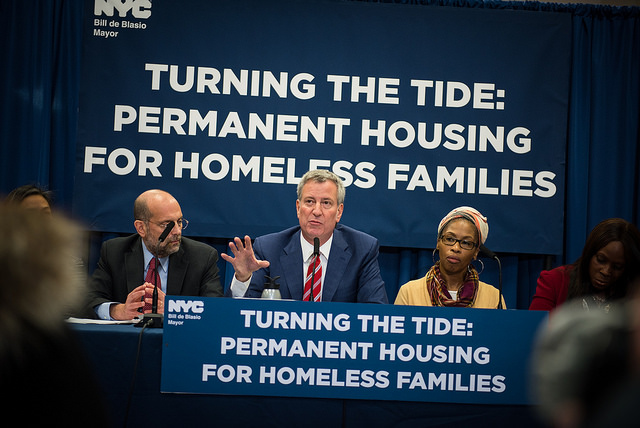
(photo: Edwin J. Torres/Mayoral Photography Office)
Mayor de Blasio has been under constant fire for offering homeless New Yorkers access to just 5 percent of the units created and preserved by his 12-year, 300,000-unit affordable housing plan, even as homelessness has reached a new all-time record high. He has been confronted at his home, at the gym in Park Slope, and on the steps of City Hall, with a growing coalition of advocates, experts, elected officials, and homeless families demanding that the mayor increase that figure to 10 percent of the total, including 20 percent of all new construction. This would result in 30,000 units of affordable, permanent housing for homeless New Yorkers, with 24,000 units to be created through new construction, by 2026.
The progressive mayor who campaigned to end the “tale of two cities” has responded dismissively, sometimes with anger – and always with a series of excuses that don’t hold up to closer examination. Let’s take a look:
The mayor says his Housing New York 2.0 plan addresses the affordable housing crisis for everyone, and adding more homeless units would take access to housing away from other New Yorkers who need it. But here’s the thing: New York City’s affordability crisis disparately impacts those with the lowest incomes. There is no shortage of private market apartments affordable to higher-income households: the vacancy rate for units renting above $2,500 per month is in fact a whopping 8.74 percent, while the vacancy rate for apartments renting for less than $800 per month is only about 1 percent.
Yet a full 20 percent of the mayor’s housing plan is for households making between $70,000 and $142,000 annually, at rents ranging from $1,700 to $3,500 per month, while at the same time dedicating a mere 5 percent to help homeless New Yorkers. Fully 10 percent of the apartments created through the mayor’s plan will have rents at or above $2,500 per month, a level at which there is currently a glut of vacant units. The mayor’s housing plan should target its help for those who need it most.
The mayor says his housing plan is just a small part of what the city is doing to address homelessness. That much is true, but it is not a fact to be proud of. Mayor de Blasio plans to build only 200 new apartments per year for homeless New Yorkers out of the 10,500 apartments per year to be constructed between now and 2026. Other programs implemented by the city that serve homeless people with disabilities, help pay off rent arrears, or provide subsidies for market-rate apartments can’t meaningfully reduce homelessness unless the city also sets aside far more newly-constructed housing for the homeless. The numbers bear this out: homelessness continues at record levels five years into de Blasio's New York, with more than 63,500 people sleeping in city shelters each night, including over 23,000 children. They are paying an extraordinary price for bad policy, as is our city as a whole.
And finally, the mayor says that adding more homeless housing to his plan is not financially feasible. But the House Our Future NY Campaign is urging Mayor de Blasio to designate just 10 percent of his overall housing plan, including 20 percent of the new construction target, for homeless New Yorkers: 30,000 units overall, with 24,000 to be created through new construction. Funds the mayor has already committed to the plan, including over $1.3 billion in city funds each year for the next eight years, show that the mayor has the resources to significantly reduce homelessness. He simply lacks the will.
The mayor’s obstinacy in the face of record homelessness and an ongoing housing crisis for low-income New Yorkers belies his professed values as a progressive leader. Without swift course correction, this wrong-headed approach will lock the City of New York in a state of ever-expanding homelessness for the foreseeable future. The only way out is with bold solutions. Mayor de Blasio must immediately dedicate 10 percent of his housing plan, including 20 percent of all new construction, to house homeless New Yorkers. Tens of thousands of our neighbors languishing in shelters and on the streets – indeed all New Yorkers – deserve a housing plan that offers a responsive and robust answer to record homelessness, not more equivocation in the false promise of fairness for all.
A full examination of the Mayor’s claims can be read in a new policy brief released by the Coalition for the Homeless here.
***
Giselle Routhier is Policy Director for Coalition for the Homeless.
***
Have an op-ed idea or submission for Gotham Gazette? Email This email address is being protected from spambots. You need JavaScript enabled to view it.
New York Needs to Restore Access to Driver’s Licenses for All in 2019
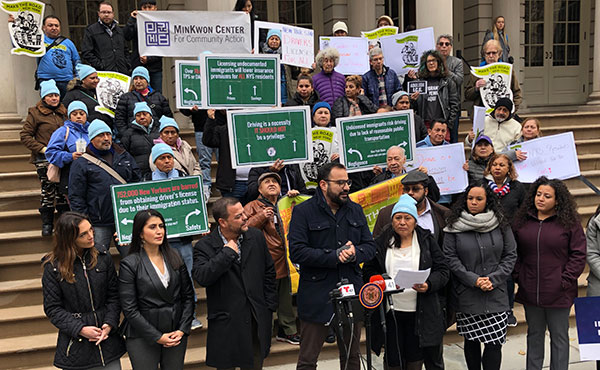
a rally for driver's licenses for all (photo: Make The Road New York)
For many New Yorkers who cannot access public transportation and need to drive, a routine traffic stop can lead to something much worse than a ticket; it can lead to deportation. That’s why restoring equal access to driver’s licenses for all New Yorkers is not controversial, it is a necessity.
All over the state, immigrants need to go to work, school, and attend doctor’s appointments, but in places like upstate New York, Long Island, and parts of New York City, a lack of public transportation means driving is the only option.
Jorge Cotraro, a father and husband on Long Island, has been forced to drive without a license because he needs to get to work, and on time, and because missing his children’s doctor’s appointments is also not something he can afford. Every time that Jorge is forced to drive, he leaves his home with fear and uncertainty if he will be able to come home to his family because a routine traffic stop can lead him down the path to deportation. That’s because interactions with local law enforcement can trigger immigration consequences, as they’re often used by Immigration and Customs Enforcement (ICE) to justify detention and deportation. And it’s why Jorge, a member of community organization Make the Road New York, has joined his neighbors to fight for driver’s licenses for all across the state.
New Yorkers should not fear that they will be separated from their family. For the first time in a decade, in January the New York State Legislature will be under complete Democratic control, with leading legislators in all chambers of state government who have stated publicly that they support restoring driver’s licenses for all. Legislation we strongly support will achieve this vital goal, and it’s time for us to move ahead and pass it in 2019.
The legislation would allow the Department of Motor Vehicles (DMV) to issue a Standard License to all New Yorkers, regardless of immigration status. Immigrant New Yorkers, regardless of their immigration status, would then be able to be properly licensed as well as operate a registered, inspected, and insured vehicle -- helping make everyone safer.
Besides being the right thing to do, this would lead to an economic boost to New York State. According to the Fiscal Policy Institute, passing this legislation would yield an estimated $57 million in combined annual government revenues, plus $26 million in one-time revenues projected as a result of people getting licenses and purchasing vehicles. It’s no wonder that 12 states throughout the country, and Washington D.C and Puerto Rico, already allow all people of a certain age, regardless of immigration status, to drive. It’s also why our neighbors in New Jersey are moving towards passing a similar measure.
Equal access to driver’s licenses for all will not only boost our economy and protect people like Jorge and his family, but it makes sense for the public safety of all New Yorkers. One of us is the ranking member of the Crime Victims, Crime and Correction committee, and it is imperative that New Yorkers, regardless of immigration status, are able to come forward to report a crime. Undocumented New Yorkers should not fear prosecution for not having proper identification when coming in contact with local law enforcement.
Support from elected officials for this effort is strong across the state. Governor Cuomo has said he supports this plan. In upstate New York, Saugerties Police Chief Joseph Sinagra and his police department have spoken in favor of the “Driver’s License Access And Privacy Act.” Brooklyn Borough President Eric Adams has expressed the urgency and New York City Comptroller Scott Stringer supports it. Many new State Senators-elect from across the state have expressed their support, making for strong momentum as the new Democratic majority takes the Senate reins in January.
It is time we take the necessary steps to protect our communities, make our roads safer, and boost our economy. It’s time to restore access to driver’s licenses to all.
***
Luis Sepulveda is the New York State Senator for the 32nd District and sponsor of the driver’s license legislation. Javier H. Valdés is the Co-Executive Director of Make the Road New York. On Twitter: @LuisSepulvedaNY @JavierHValdes @MaketheRoadNY.
***
Have an op-ed idea or submission for Gotham Gazette? Email This email address is being protected from spambots. You need JavaScript enabled to view it.
Moving Toward a Metro-Regional Approach to Planning and Advocacy
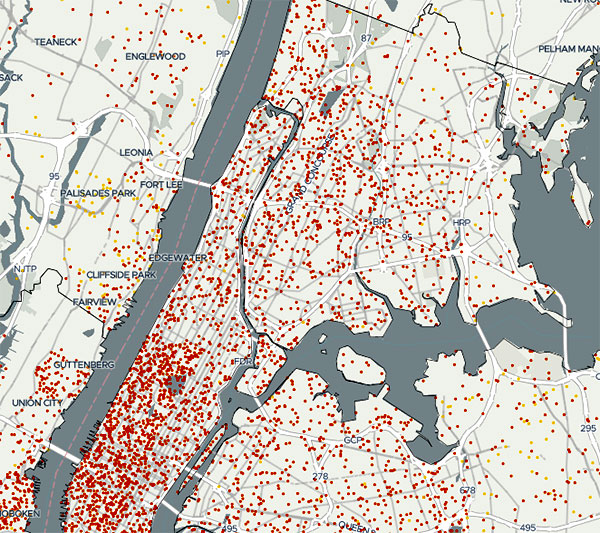
(photo via NYC Planning)
New York City and its neighbors have a problem. Unlike Los Angeles, Chicago, and the other major U.S. metropolitan areas that fit neatly within the standard city, county, and state political boundaries, our metropolitan area of over 22 million people does not. We’re spread out over four states and 26 counties, five of which are called “boroughs” and were integrated together to create our city over 100 years ago.
All these complex boundaries and jurisdictions have resulted in a metropolitan area that has been “divided and conquered” by the politics of patronage, enabling networks of political insiders and special interest groups to dominate New York City’s electorate, advancing their own interests at the expense of ours. This has resulted in our area’s city and state governments passing higher taxes and providing lower quality services, more corruption, and less infrastructure investment than comparable cities and regions around the world.
We deserve better.
People living in the New York Metropolitan Area (NYMETA) might live over 100 miles apart, but we still work at the same jobs and in the same industries, go to many of the same universities and hospitals, and root for (or at least have strong opinions about) the same sports teams. We often travel the same roads, ride the same train lines, use the same airports, drink from some of the same aquifers, eat the same foods, and get rained on from the same clouds.
With so much shared environment and infrastructure, you’d think that there would be powerful entities helping us align our shared interests, coordinate our actions, and deliver us results at a regional scale. Unfortunately, that isn’t happening.
There is no single entity or group responsible for systematic coordination within our metropolitan area. Instead, we have a hodgepodge of coordinating bodies spanning different sectors, areas and functions. Sometimes those bodies are prestigious nonprofit entities with relatively meager budgets like the Regional Planning Association, other times they’re multi-state authorities with huge budgets run by political elites like the Port Authority, and often it’s informal coordinating bodies that do little more than network individuals and hold annual meetings, and most commonly, there is just no coordination taking place at all.
What types of opportunities could a better coordinated region be generating? Here are some examples.
We’re experiencing a housing crunch in New York City, and there are a myriad of housing development opportunities in the Hudson River Valley and tons of New Yorkers who’d happily commute from a high rise in Poughkeepsie to a job in Midtown Manhattan if the commute could be done in under two hours and for a reasonable price. A coordinating body -- let’s call it NYMETA -- would be responsible for bringing all the players together: Metro North Railroad, town governments, real estate developers, and New York City to streamline regulatory processes, align incentives, and get deals made and buildings built.
Another example: New York City schools are feeding over a million kids a day, our regions small farms are looking for reliable consumers of their products, and the school system is looking for locally sourced healthy food, but their corporate contractors are trucking in frozen produce from hundreds of miles away. The city is also building programs that expose youth to nature, rural communities, and agricultural-based industries. NYMETA could work with rural counties to help them aggregate and organize food supply, and work with New York City to aggregate and organize school demand, and then build the relationships needed to get our kids eating healthy local food and empowering our regional farmers at the same time.
Beyond managing classic coordination challenges like road and rail linkages, we also need an entity that can represent our region on the national and global stages, where major cities and their regions are playing an increasingly important role in global affairs. Many leaders, including major CEOs, politicians, philanthropists, philosophers, and futurists have predicted that, over the course of the 21st century, nation-states will cede more and more political power to cities and metro-regional governments, and those governments will network together to coordinate policies at global scale.
Evidence of the rise this “municipalist” power structure is everywhere, from the United Nations HABITAT conference that brought cities together through the U.N. structure for the very first time in 2016, to various networks of city governments like the League of Cities and Networks of Cities, and through outcomes like the C40 process to tackle global warming. Places like Paris and Los Angeles have, through the luck of sensible political boundaries, entities that can, to some extent, represent their metro region at these events. NYMETA could perform this function for us, enabling our region to leverage our massive population and other resources when negotiating agreements and deals with other major global regions, not to mention what could be done within the U.S.
An important step towards any political organizing project is collecting and displaying the most basic information about geography and demographics. Who would fall within a metro regional government? What would its boundaries be? The new Metro Region Explorer website from New York City’s premier digital service organization, NYC Planning Labs, answers these questions with an open source software tool that mashes a bunch of datasets about our metro region together to provide data-driven stories about demographics, employment, housing, and other baseline statistics needed to understand our region.
Unlike many GIS tools with lots of confusing check boxes that you need to click off and on to get useful information, Metro Region Explorer does the work for you by giving you some stories you can toggle through and menu items that reveal the most important data. Click around the site and insights will likely pop into your head as they did mine: New Jersey is building tons of housing while western Nassau and eastern Westchester counties aren’t. Lots of jobs are moving out of Connecticut and into New York City and Long Island. Central Jersey has a huge immigrant population. Wow.
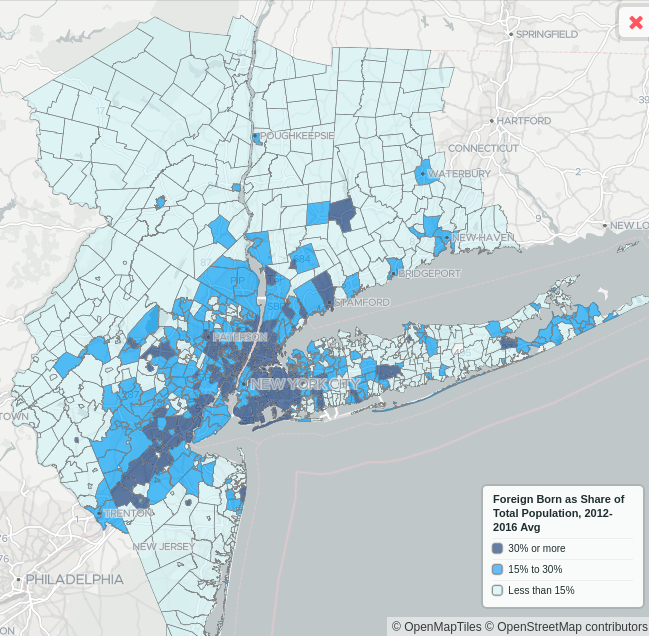
Metro Explorer isn’t just a cool mapping tool for planning nerds. As Gotham Gazette reported in its article “With New Data, City Takes First Step Toward Regional Planning,” its development indicates that the city is getting serious about improving our region’s capacity to understand itself and coordinate between and among jurisdictions.
As the largest government with the most capacity in the region, it’s up to New York City to begin the process of developing a more integrated regional coordinating body. But building a dedicated office to do this work is not enough. We need an entity accountable to the 22 million people, 900 municipalities, and 26 counties of NYMETA. Developing such an entity will produce tangible benefits in the short term and create a whole new set of opportunities over the long term.
It’s time to start envisioning NYMETA.
***
Devin Balkind is a technologist and nonprofit executive who works on civic technology projects in New York City. On Twitter @DevinBalkind.
***
Have an op-ed idea or submission for Gotham Gazette? Email This email address is being protected from spambots. You need JavaScript enabled to view it.
Handicapping the Public Advocate Special Election
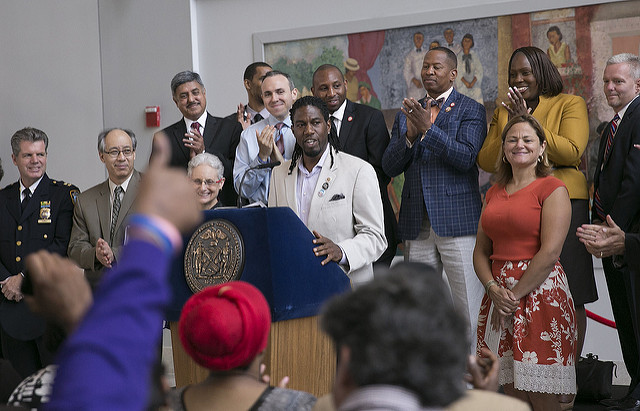
Jumaane Williams & Melissa Mark-Viverito (photo: William Alatriste)
New Yorkers who think they are done with elections until 2020 will be in for a rude awakening when Mayor Bill de Blasio calls a special election to fill the vacancy of the Public Advocate position. The position’s current occupant, Letitia James, was elected in November to become New York State Attorney General, and will switch posts at the beginning of January. In all likelihood, New York City voters will head to the polls again at the end of February. With so much at stake—the Public Advocate is next in line in the case of a mayoral resignation or death—New Yorkers need to know the lay of the land in this important race.
The Top Candidates
As can be expected for an open seat election, there is a crowded field of candidates vying to replace James. Who are the top candidates? I believe there are four in the top tier:
Michael Blake
The young Bronx Assembly member is undoubtedly a formidable candidate. Blake is smart, charismatic, and ambitious. He has several things to capitalize on in this race. One, he’s a vice chair of the Democratic National Committee and former member of the Obama administration. His relationship with national Democratic leaders can surely help him raise money quickly, which he did for his initial Assembly win in a competitive race. Being able to raise money quickly in this type of race, which is citywide and short by law, will give him a distinct advantage. Blake is also, at the time of writing, the only Bronx candidate. Manhattan and Brooklyn each have several candidates vying for this seat, so Blake can potentially overwhelm his opponents in the Boogie Down borough.
Melissa Mark-Viverito
As the former speaker of the City Council, Mark-Viverito will be one of two candidates in this race with higher name recognition. In such a shortened and fast-paced election, name recognition will be especially pivotal. Furthermore, Mark-Viverito has always maintained close relationships with key labor groups, having once been employed by the state’s biggest union, 1199 (though Blake also has close ties to 1199). If some of these bigger labor groups decide to back her, she will be a force to be reckoned with. There are some observers that list Mark-Viverito’s Latina background as another advantage, but with City Council Member Ydanis Rodriguez in the race (he represents a district with the highest Latino turnout in the city), as well as City Council Member Rafael Espinal, it is not a given that Mark-Viverito will win the lion’s share of the Latino vote.
Danny O’Donnell
The Upper West Side Assembly member (and brother of comedian/actress Rosie O’Donnell) has long represented the district with the highest Democratic turnout in the nation. As was evident in Scott Stringer’s 2013 race for Comptroller, among others, the Upper West Side vote can be pivotal in a close race. As a long-time progressive champion, and representing this key region of the city, O’Donnell will be one to watch.
Jumaane Williams
The Brooklyn City Council member is coming off an impressive lieutenant governor race against the eventual winner, Kathy Hochul. Without a doubt, Williams will join Mark-Viverito as the other candidate with the highest name recognition. Yet Williams is hardly a shoo-in for this seat. In that most recent race, he benefited from a certain wing of the Democratic electorate that has been dissatisfied with Governor Cuomo. Williams was able to capitalize on that voter dissatisfaction then. But this is a quite different race.
Key Outside Players
In an election such as this one—a shortened election cycle and a citywide race with candidates that are generally unknown to the wider electorate—the impact of outside groups could be great. Here are a few of the most prominent potential players in the special election for Public Advocate who could help swing the race.
Labor
Big labor unions can potentially play an outsized role in this race; unions such as 1199, DC 37, 32BJ. These labor groups come with proven and well-oiled political operations that can be quickly put to use on behalf of their candidates, including their access to foot soldiers readily available to promote candidates. Yet much will hinge on whether labor agrees to back one candidate or splinters into different factions -- or if most unions stay out of the race altogether given the many candidates and unpredictable nature.
PACs
The 2013 citywide elections saw the rise of outside interest groups that spent loads of money on city races for mayor through City Council. Some of the PACs were formed by real estate interest groups and some by charter school advocates, among others. Millions were poured into races across the city. Will these groups see a need to invest in this special election?
Party Organizations
While the influence of party organizations continues to wane, two party committees persist in wielding some influence—the Queens and Bronx Democratic organizations. In a shortened campaign season, a unified party operation could impact the election. It remains to be seen who these respective party organizations will endorse, and eyes should stay focused on what Chairs Joe Crowley and Marcos Crespo will do.
Where will the race be decided?
History suggests that special elections elicit low voter turnout. This election for public advocate will likely be no different, especially since the election will probably take place in February. New York City voters are not accustomed to battling the brisk winter air to get to the polls.
To complicate matters further for political observers and analysts in New York, there is really no precedent when it comes to a citywide special election, since we have not had one in recent memory. But perhaps the public advocate runoff election of 2013 can suggest how voter participation might look in such a context.
Interestingly, 67% of that vote, when James defeated then-State Senator Dan Squadron, came from Manhattan and Brooklyn. Given Brooklyn’s size and Manhattan’s solid voting participation, expect similar numbers this coming February. What these numbers mean for the respective candidates will remain to be seen. But they would be wise to focus efforts in those two boroughs.
It will be an intense, crowded, short race. Let the campaign for public advocate begin!
***
Eli Valentin teaches political science at Monroe College and is a frequent guest political analyst on Univision NY. On Twitter @elivalentinNY.
***
Have an op-ed idea or submission for Gotham Gazette? Email This email address is being protected from spambots. You need JavaScript enabled to view it.
Several Roads to Decarceration, All of Which Should Be Taken
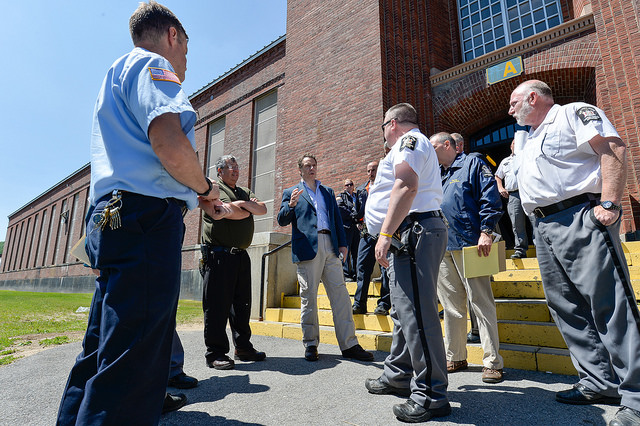
(photo via the Governor's Office)
As the year comes to a close, it is undeniably true that criminal justice reform is in the air. The federal First Step Act, even with critics on the left and right, heralds a less punitive approach than the “get tough on crime” policies of the past several decades. Recent elections yielded a number of prosecutors swept into office on platforms focused on confronting racial disparities and rethinking approaches to low-level offenses. Earlier this month, hundreds crammed into a hotel in West Hollywood for a Criminal Justice Summit that brought together activists, journalists, celebrities, and philanthropists to talk about dismantling the punishment paradigm that has inflicted incalculable damage on communities of color.
All of these efforts are righteous and long overdue but we need to think more expansively to redress the past 50 years of hyper-aggressive policing, processing, and punishing, and to make a dent in the physical embodiment of the plague of mass incarceration – the 2.2 million people, disproportionately black and brown, currently behind bars.
To be crystal clear, this is not about innocence or so-called low-level, non-violent drug offenders. To tackle mass incarceration means facing head-on an emotionally charged question about punishment – how long must someone serve in prison for an admittedly violent act?
Last year, the august American Law Institute, a non-governmental organization of judges, lawyers and academics, approved the first-ever revisions to the historic Model Penal Code. One recommendation specifically addresses the epidemic of people behind bars. The Code now calls for state legislatures to enact a “second look” provision; to create a procedure to reexamine a person’s sentence after 15 years regardless of the crime of conviction or the length of the original sentence. Such a law would be a legislative recognition that a sentence once imposed is not thereby automatically rendered, just, fair and appropriate for eternity.
There are several paths for newly-elected prosecutors to take to foster decarceration. One requires rethinking their approach to applications for parole, clemency, or resentencing. The common practice in most prosecutors’ offices is to oppose those applications when the crime of conviction was violent in nature. In those cases, the prosecutor’s focus is on the crime itself to the exclusion of serious consideration of who the person is today, decades after the crime. Instead, prosecutors should carefully examine who the person is at present -- what programs has he completed; has he shown insight into who he was and what he did; has he acknowledged his role in his crime, accepted responsibility, and conveyed genuine remorse for the harm he caused? Ultimately, is the evidence of rehabilitation such that more time in prison serves no purpose beyond inflicting eternal punishment?
Many prosecutors’ offices now have Conviction Integrity Units that aim to ensure that innocent people have not been convicted. The best of these units have a significant measure of independence so that they can be as objective as possible and avoid the pitfalls of confirmation bias and tunnel vision. In similar fashion, prosecutors should establish independent Sentencing Review Units. Much like the legislation proposed by the Model Penal Code, these units would review all sentences after 15 years to determine whether a reduction is now appropriate.
Parole boards across the country are regularly roundly criticized. It is common practice for cronyism to mark membership on the board in lieu of a diligent selection process looking for diverse and qualified people with directly relevant backgrounds and experience. It is also common knowledge that parole boards are reluctant or unwilling to release anyone serving time for a violent crime.
The laws, rules and regulations governing parole must be amended to dictate a forward-looking approach centered on what the person has accomplished while incarcerated, as opposed to the prevalent current practice that emphasizes the seriousness of the crime, a fact that can never change. This shift would also acknowledge the countless parole-eligible people who have aged out of crime and present no threat to public safety, as well as the elderly behind bars who are in the midst, or on the cusp, of health related problems.
In Pennsylvania, more than 100 people have been released since the Supreme Court ordered states to take a second look at people who had received mandatory sentences of life without parole as juveniles. Not one of those people has been convicted of a new offense.
All 50 state constitutions allow for some kind of executive clemency. The authority to grant clemency in the form of a sentence commutation is typically described as absolute and virtually incontrovertible. Power of the sort galvanized at the Summit in West Hollywood should be marshaled to compel governors to exercise their virtually unfettered, but seldom used, power to grant clemency.
The timing is right -- besides the current clarion call for criminal justice reform, clemency is traditionally an end-of-year announcement cast as an act of benevolence consistent with the merciful spirit of the holidays. Just last week, California Governor Jerry Brown granted 70 sentence commutations, including for people convicted of murder.
The crisis of mass incarceration has fueled a burgeoning movement for criminal justice reform. Multi-pronged efforts to decarcerate must be at the forefront of that movement.
***
Steven Zeidman is a professor of law at CUNY School of Law. On Twitter @SteveZeidman.
***
Have an op-ed idea or submission for Gotham Gazette? Email This email address is being protected from spambots. You need JavaScript enabled to view it.
Term Limits Heighten Need for Community Boards to Become Data Literate
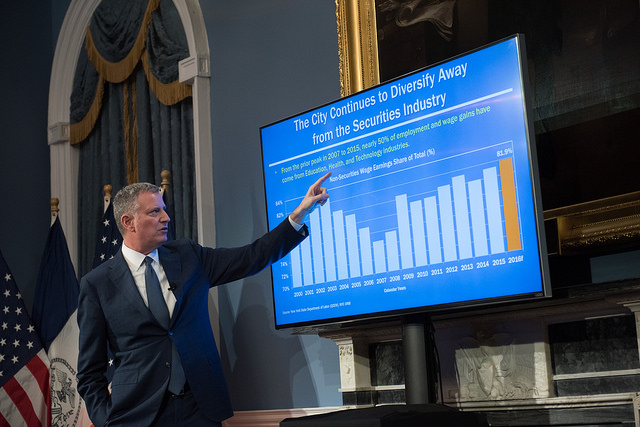
(photo: Michael Appleton/Mayoral Photography Office)
On November 6, New York City voters approved a ballot proposal to impose term limits on community board members for the first time since their role was written into the city’s Charter in 1963. The proposal was introduced by Mayor de Blasio’s Charter Revision Commission and proved to be the most contentious of the three proposals listed on this year’s ballot.
Several City Council members and one borough president, among others, argued that imposing term limits would help diversify boards that have historically failed to represent the demographics of the neighborhoods they represent. Dissenters argued that forcing the removal of long-term members would threaten the already tenuous authority of boards to oppose land use and licensing proposals that would negatively impact their communities. These folks claimed that limiting board terms would undermine the board’s institutional knowledge and would make it possible for real estate developers to take advantage of inexperienced board members.
The debate, at least because of the opposition argument, pins diversity against authority - representative democracy against an ability to get things done; it subtlety though forcefully suggests that community boards - the city’s most local formal government body, of which there are 59 across the five boroughs - cannot have both. How has it become so intractable for boards to effectively and legitimately speak on behalf of their communities, while also reflecting the composition of their communities? At BetaNYC - a community-based organization dedicated to improving lives in New York through civic design, technology, and data - we believe that disparities in information and information infrastructure play a major role in propagating this problematic dichotomy.
In local New York City governance, there is a significant power imbalance when it comes to who has access to information, who has the expertise and experience to manipulate it, and who has the authority to present it as evidence. When coming before community boards, real estate developers and business owners often gather and aggregate data to craft a narrative as to how their proposals will positively impact a community or to demonstrate how their proposals will not harm a community. Developers may suggest that a rezoning will result in a certain number of new jobs or new affordable housing units to sway a community board towards supporting their proposal. A restaurant owner may present data to argue that setting up a sidewalk café will have minimal impact on foot traffic and pedestrian safety.
Since community boards can only put together advisory resolutions, it is important for them to be able to legitimate their arguments for or against the proposals with evidence. However, many community boards do not have the technical literacy or infrastructure to fact check the presented data or to offer counter-posing statistics. With the approval of the term limits ballot proposal, their ability to do so is further compromised.
It takes time to learn the intricacies of zoning and licensing law, let alone to develop the skills to aggregate and present data in ways that can affect zoning and licensing decisions - all of which board members must accomplish on volunteered time. The fact that elected officials are concerned that diversifying board voices will undermine the board’s authority highlights a much deeper issue - that the balance of information access, expertise, and legitimacy in the city’s formal decision-making processes is far from equitable and just.
Ironically, the information and expertise that community boards do bring to their positions - rich experiential knowledge of the history, people, and problems that characterize their communities - often gets written off as anecdotal evidence or angry voices as their advisory resolutions move through the city’s processes. This evidence is often considered to lack the authority of seemingly more objective (and less passionate) quantitative data. An unfortunate consequence of discourse around “data-driven decision-making” is that numbers and statistics have become a privileged form of evidence - with little reflection on the disparities in who controls these numbers and statistics, and what other forms of evidence are undermined in the process.
This is why BetaNYC has placed community boards at the center of our vision to expand civic data literacy and advocate for civic data infrastructure in New York City.
We believe that communities are empowered when their community boards are equipped with both the knowledge and the resources they need to challenge information practices that ignore or misrepresent people and problems in their neighborhoods. Since 2015, BetaNYC has been researching the technical and information infrastructure available to community board district offices and the data training offered to community board members and district office staff. We have documented the challenges boards face in leveraging the city’s open data resources to advance their resolutions, and have outlined several specific use cases in which community boards could leverage city or state data to back up their claims.
The results of this research are summarized in a report we published in October 2017, entitled “Data Design Challenges and Opportunities for NYC Community Boards.”
Through this research, we have been able to expand our technical offerings, develop new open data curriculum, and foster new collaborations with the Mayor’s Office of Data Analytics (MODA) and the Department of Information Technology and Telecommunications (DOITT). We produced BoardStat (a 311 data dashboard), SLA Mapper (a tool to track noise complaints, underage drinking complaints, and restaurants healthgrades for bars seeking liquor license renewals), and Tenants Map (a tool that maps rent-stabilized units and housing-related 311 complaints to highlight potential tenant harassment).
BetaNYC also offers public training on how to use the city’s open data portal, how to map open data with Carto, and how to integrate open data with Census data using spreadsheets. We work closely with borough president offices to ensure that community boards know about and have access to these trainings. Finally, in October, we testified before the City Council in favor of legislation, Intro. 1137-2018, which would not only codify MODA into the city Charter, but also require that they offer training on the use of the open data portal to community boards. We are thrilled to see this legislation passed.
As new voices filter into community boards positions, it will be more important than ever to equip them with skills, resources, and tools to effectively advocate for their communities. If the new Civic Engagement Commission, the creation of which was also approved by voters through a ballot measure on Election Day, is going to provide technical assistance, it should focus on building up a new class of community board members who are digitally and data literate, savvy online/offline organizers, and great public facilitators. BetaNYC looks forward to working with boards, city agencies, and elected officials to ensure that these needs are met.
***
Lindsay Poirier, Ph.D., is the Lab Manager at BetaNYC and soon to be Assistant Professor of Data Studies at University of California Davis. On Twitter @lindsaypoirier & @BetaNYC. (Note: Thanks to Noel Hidalgo, Executive Director of BetaNYC, for advice on this piece.)
***
Have an op-ed idea or submission for Gotham Gazette? Email This email address is being protected from spambots. You need JavaScript enabled to view it.
Rebooting the Republican Party in New York City
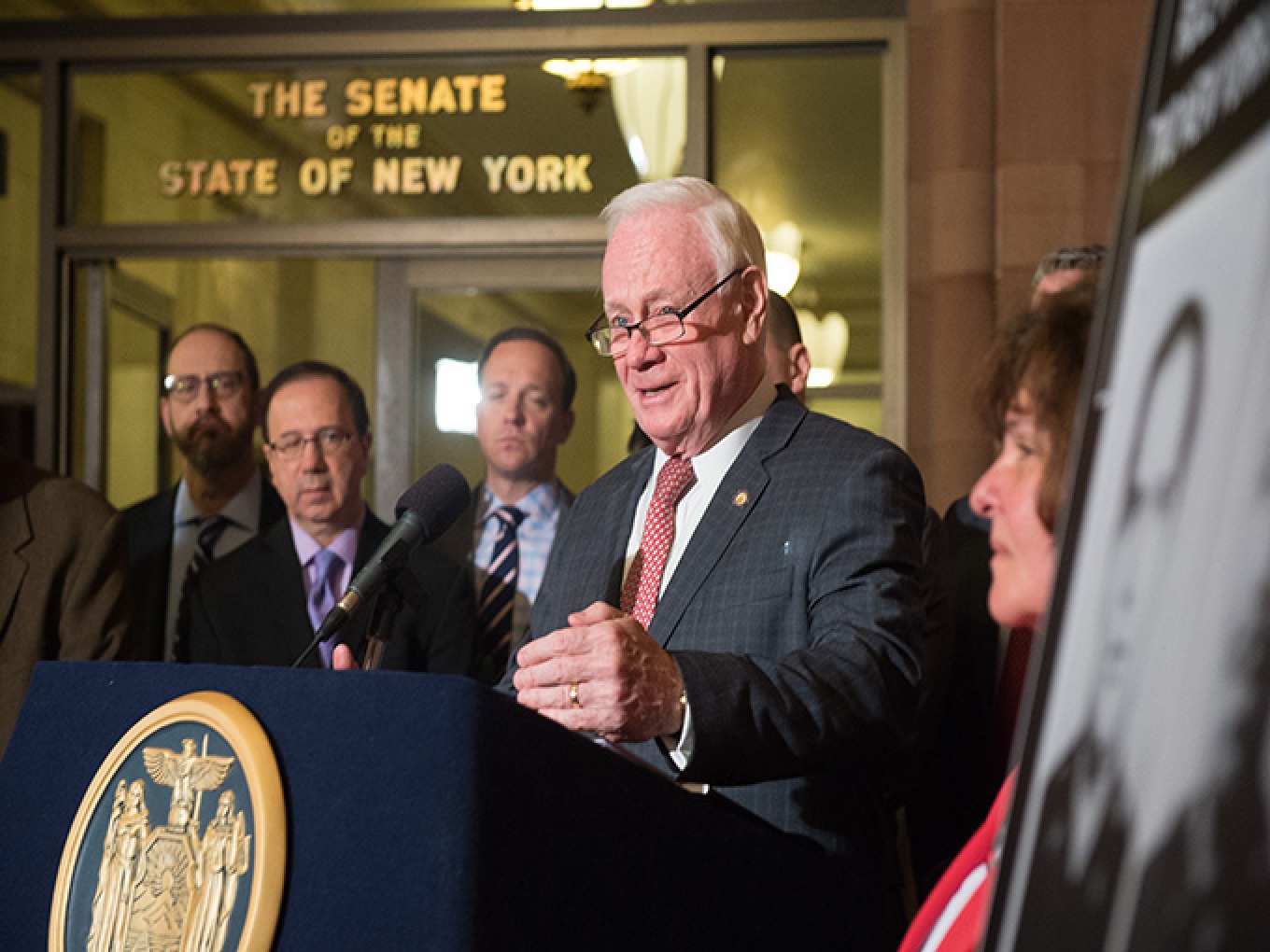
Senator Marty Golden (photo via State Senate website)
The fall of State Senator Marty Golden and Congressional Rep. Dan Donovan should put the Brooklyn Republican Party on notice: there is a need for younger, more diverse candidates that can connect with the community, and provide unique solutions to problems plaguing our urban neighborhoods.
It’s no secret that New York City is a liberal bastion that has made it difficult for Republicans and the Republican Party to find an audience. However, that is just as much the fault of the local party apparatus as it is the tribalist politics of the five boroughs. The Brooklyn GOP has so far failed to reflect the people it’s trying to represent.
I agree with Republican Congressional Rep. Mia Love of Utah, recently defeated as she sought reelection, when she said, “Republicans never take minority communities into their home and citizens into their homes and into their hearts, they stay with Democrats and bureaucrats in Washington because they do take them home – or at least make them feel like they have a home.”
Today’s voters look to leaders who care about their needs. And to the vast majority of New York City voters, the Republican Party has become synonymous with callousness and corruption.
However, empathy and conservative principles are not mutually exclusive. If Republicans want to broaden our appeal among college-educated urban and suburban voters, we need to revisit George W. Bush’s compassionate conservatism.
We need to fight for people, not abstract concepts.
The next generation of Republicans must reaffirm a better future for all. We must get back to basics and start reconnecting with local communities – speak their language (even literally) – and, for example, explain what we would do to fight residential displacement.
New York City Republicans need to reach out to minority communities and refocus party priorities on bipartisan issues that the Mayor, the City Council, and Albany have consistently dropped the ball on, from housing to education, criminal justice to healthcare.
We need a message that sets us apart, that moves us beyond the demagoguery of Donald J. Trump and provides solutions to problems plaguing so many New Yorkers.
If that means adopting some liberal ideas, or compromising in order to codify a kinder, more gentler society then that is exactly what we should do – and we absolutely can do it without sacrificing our core principles of fiscal probity, free enterprise, personal freedom, individual responsibility, and self-government.
According to the New York State Board of Elections, there are 3.5 million registered Democrats and 522,540 registered Republicans in New York City.
Time to face reality.
The GOP has a lot to offer, but we need to figure out what we’re offering in an urban environment like New York and we need to be consistent here.
We have an obligation to stand up for everyday New Yorkers who are struggling to make it, who yearn to start a family, or are striving to raise one. If we’re about the working class then our statutes and our systems need to sing it from the rafters. We can’t get caught up in the quagmire of self-aggrandizement or appeasing special interests; it’s the overall community that matters, not party, and not corporate interests.
If we’re for rooting out corruption, then let’s root out corruption. No more corporate PAC money. No more labor union money. Only individuals.
And yes, we can have a great message, but messaging means nothing without the proper messengers.
Running young, qualified, well-vetted candidates that reflect local communities is our best way of communicating our ideas to a new audience. Communities outside of parts of Manhattan, brownstone Brooklyn, western Queens, and a few other places have been ignored and require more forceful, more vociferous representation at the state level.
Ultimately, it’s not about right versus left, Democrat versus Republican, but instead practical versus fantastical; smart versus irresponsible. There are major crises in state finances and with homelessness, public housing and public transportation; income inequality has sky-rocketed, and Democrats have few solutions other than spending more money. The status quo of corporate welfare is not working; New York’s business climate now consistently ranks 49 out of 50, according to the Tax Foundation.
We need to rethink how we’re doing almost everything in New York -- and Republicans can be the party of ideas and solutions.
This past election cycle has left many New York Republicans searching for answers. We can start to build a new Republican Party in New York City and State before it really is too late.
***
Joel Acevedo is a board member of the Brooklyn Young Republican Club and founder of the Sunset Park Republicans. On Twitter @JoelMAcevedo.
***
Have an op-ed idea or submission for Gotham Gazette? Email This email address is being protected from spambots. You need JavaScript enabled to view it.
A Simple First Step to Help the MTA Re-Establish Credibility

Andy Byford (photo: Marc A. Hermann / MTA New York City Transit)
This is part of AGENDA 2019, a joint Gotham Gazette-City Limits project
Find the rest of the series here
The Metropolitan Transportation Authority (MTA) is teetering on financial collapse and still struggling to overcome a meltdown in subway service and collapse in bus ridership. No one doubts that the MTA has serious problems and riders are suffering. But before the State Legislature approves tens of billions of new funding, the MTA needs to show it is serious about improving its decision-making and transparency.
Politically, the MTA has met the enemy: its lack of credibility.
Former Chair Joe Lhota at the MTA Board’s October 2018 meeting acknowledged this, saying, “I’m aware that before we can credibly appeal for billions of dollars of public money, we must continue to advance a reform agenda.” New York City Transit’s Fast Forward plan is a whopping $40 billion appeal and promise to improve the subways and buses. Andy Byford, New York City Transit’s president and the plan’s architect, in unveiling the plan stated that NYCT is working on the “rollout of a new transit organization - one that is built around a customer centric, continuous improvement model, one that emphasizes transparency and accountability, and one that going forward delivers on its promises.”
One of the easiest ways for the MTA to show that it is serious about improving transparency is to bring its Freedom of Information Law (FOIL) process into the 21st century. This means putting it fully online with an OpenFOIL website, modeled on the successful platforms already used by the Port Authority of New York and New Jersey and the City of New York, and as developed by the Obama administration for federal agencies.
The idea behind FOIL is that the public can ask for and get information that government decisions are based on -- information that we, the public, paid for with our taxes (and, in some cases, fares and tolls). Ideally, much of this information should already be online in an open format that is easy to search, download and use. But in 2018, the MTA is still a long way from putting important information online and in accessible formats. For journalists, researchers, and watchdogs that seek to hold the MTA accountable, that means FOIL is often the only way to get certain public records.
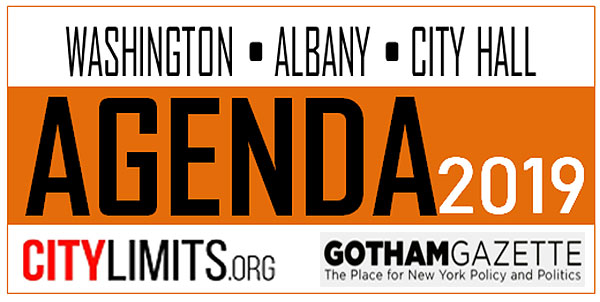 Unfortunately, the way the MTA implements FOIL is not working for either MTA staff or the public. A recent report by my organization, FOIL that Works: Increasing MTA transparency and accountability by putting FOIL online, dug into the MTA’s FOIL process and found a dysfunctional and fragmented mess.
Unfortunately, the way the MTA implements FOIL is not working for either MTA staff or the public. A recent report by my organization, FOIL that Works: Increasing MTA transparency and accountability by putting FOIL online, dug into the MTA’s FOIL process and found a dysfunctional and fragmented mess.
The MTA received nearly 9,000 requests in 2017 (see chart below), with those inquiries handled differently among its eight separate agencies. New York City Transit still responds to many FOIL requests with paper letters instead of by email. Complicated requests can take over a year to fill, and most FOILers don’t have the legal resources to take the MTA to court to speed things up. FOIL requests might be deemed “closed” by agency staff, but this does not mean the requestor actually received the information sought.
There is a better way to do things, and fortunately for the MTA, it doesn’t have to look far. The Port Authority in 2012 revamped its freedom of information access policy, and created an online portal for FOI requests. This reform was led by Pat Foye, then the Port Authority executive director, and now the MTA’s president, as well as Scott Rechler, who has since switched boards to the MTA. Now, once a record is released to the public, it goes online in a searchable portal for everyone else to benefit from. This saves both the Port Authority staff and the public time - a win-win.

The City of New York also has an Open Records web portal, which eases the FOIL process for the public and agency staff. The code for the portal is available in open source, which is essentially free for the MTA to adopt and expand for its needs.
The MTA also doesn’t segregate information requests the way it should. As shown in the chart above, in 2017 two-thirds of MTA FOIL requests - more than 6,000 - were for police incident reports. But these don’t have to go through FOIL. The state Department of Motor Vehicles has an in-house online collision reports portal where the public can privately request their own incident reports, and the MTA should do the same. The MTA’s FOIL staff should focus on other types of FOIL requests to ensure that they don’t languish for so long.
OpenFOIL and an online police incidents portal for the MTA are supported by 13 other city, state, and national organizations - a diverse group including good government, transportation, freedom of information, and environmental organizations including the National Freedom of Information Coalition, Riders Alliance, League of Women Voters of the City of New York, NYPIRG Straphangers Campaign, and Environmental Advocates of New York.
The MTA can and should put FOIL online on its own. But should it not, the public has another important backstop - the state Legislature. Newly elected and re-elected legislators, in particular Senate Democrats, have promised to tackle MTA reform, and if the MTA can’t reform itself, they should require it. Passing legislation requiring OpenFOIL for the MTA is a great start for legislators to take their oversight role seriously.
This is part of AGENDA 2019, a joint Gotham Gazette-City Limits project
Find the rest of the series here
***
Rachael Fauss is Senior Policy Analyst at Reinvent Albany. On Twitter @RachaelFauss & @ReinventAlbany.
***
Have an op-ed idea or submission for Gotham Gazette? Email This email address is being protected from spambots. You need JavaScript enabled to view it.